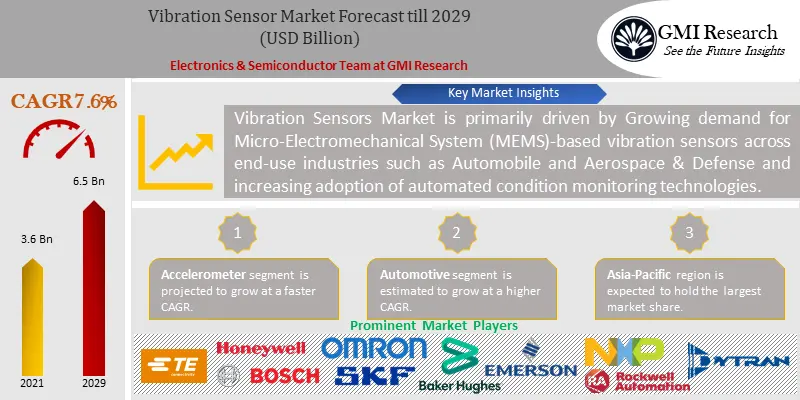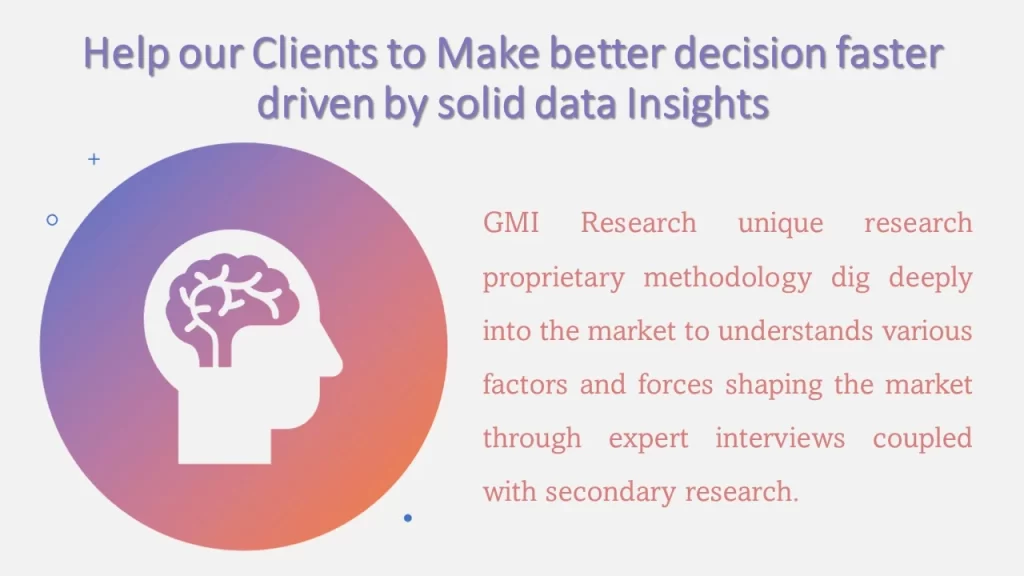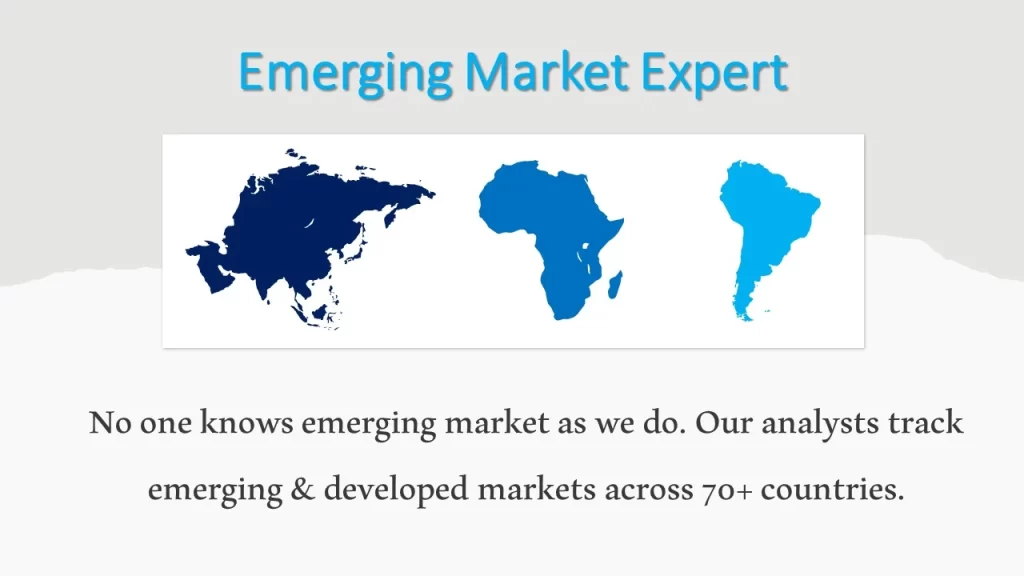Vibration Sensor Market Analysis Report by Type (Accelerometer, Velocity Sensor, Proximity Probe, Displacement Sensor), By Process Type (Portable Vibration Monitoring, Online Vibration Monitoring), By Equipment Type (Vibration Analyzer, Embedded Systems, Vibration Meter), By End User (Oil & Gas, Metals & Mining, Energy & Power, Automotive, Healthcare, Electronics & Semiconductor, Others) and By Global Opportunities & Forecast, 2022-2029
Analysts at GMI Research estimates that the Vibration Sensors Market was worth USD 3.6 billion in 2021, and forecast to touch USD 6.5 billion in 2029, growing at a significant higher CAGR of 7.6% from 2022-2029.

To have an edge over the competition by knowing the market dynamics and current trends of “Vibration Sensor Market”, request for Sample Report here
Market Dynamic
Key Drivers and Emerging Trends
Factors such as the increasing adoption of automated conditioning monitoring paired with the advent of smart factories across the world are driving the growth of the global vibration sensor market. Moreover, the industrial transformation from preventive to predictive maintenance is fuelling the growth of the vibration sensor market at a significant extent over the years. The proliferating use of vibration sensors in the railway track monitoring systems to detect the discrepancies in rails, including irregularities, dislocations, and breaks is projected to supplement the market growth. For instance, in 2019, JSPS KAKENHI awarded funding to Nihon University for the development of a vibration sensor-based rail track monitoring system. These sensors will help to detect and identify irregularities in tracks.
Advancements including developments in machine learning and big data analytics will further propel the vibration sensor market growth over the forecast period. In addition, the adoption of IIoT and advanced sensor technology is expected to supplement the growth of the global vibration sensor market. Additionally, the rising deployment of wireless systems in machine condition monitoring is expected to drive the demand for vibration sensors over the forecast period. Growth in various industries, including chemicals, energy & power, food & beverages, and healthcare, continues to witness heightened demand for vibration sensors despite the adverse impacts of the COVID-19 pandemic to ensure safe and efficient operations of machinery.
Restraint in the Vibration Sensor Market
Factors such as stringent regulatory standards and the requirement of additional costs for incorporating these solutions in existing machinery are projected to hamper the growth of the global vibration sensor market over the upcoming years.
Do you want to know more about the Research process and detailed Methodology, Request Research Methodology of this report
Type- Segment Analysis
Based on the Type, accelerometer segment is projected to grow at a higher CAGR over the forecast period. Accelerometers are increasingly used for collecting data related to vibration monitoring. The increasing usage of vibration sensors for data collection and monitoring is fuelling the market demand for accelerometers in the global vibration sensor market. Further, the rising adoption of accelerometers in diverse industries including consumer electronics, automotive, and manufacturing, among other industries is surging the growth of the market. Moreover, various vendors operating in the market, including Robert Bosch LLC and Hansford Sensors, among others are increasingly focusing on the development and advancements in tri-axial accelerometers, which is propelling the segment growth. The displacement sensor segment is anticipated to expand at a high CAGR owing to increasing adoption in the detection of stacked Printed Circuit Boards (PCB) and the positioning of electronic components on the PCB. Moreover, the growth is projected to enhance further on account of increasing adoption in automotive applications such as coolant pump and turbocharger speed. Besides, in recent years, the rising usage of displacement sensors for detecting the closure position of injection nozzle in diesel fuel injection systems is also anticipated to propel the growth.
Process Type- Segment Analysis
Based on the process type, online vibration monitoring is projected to grow at a higher CAGR over the forecast period. Online vibration monitoring is more advanced type of process in comparison with its counterpart. Further, it also provides real-time data to the plant operators for efficient monitoring. Thus, the growing demand for simpler, convenient and real-time solutions is supplementing the market growth of online vibration monitoring.
End User – Segment Analysis
Based on the end user, the automotive segment is projected to grow at a faster CAGR in the global vibration sensor market. The automotive industry is incrementally focusing on the automation and up gradation of the assembly lines, which deploys motor monitoring systems and vibration sensors. Thus, this is projected to create new growth avenues for the vibration sensor market in the automotive vertical. Moreover, in recent years, there has been an increased demand for non-destructive testing solutions in the automobile industry that has further supplemented the market growth. The aerospace and defense end user is projected to witness exceptional growth throughout the forecast period owing to the increased usage of the vibration sensor systems for aircraft health monitoring systems.
In case, any of your pain points areas are not covered in the current scope of this report, Request for Free Customization here
Regional – Segment Analysis:
Based on the region, Asia-Pacific region is expected to dominate the market over the forecast period in the global vibration sensor market. Factors including progressing industrialization, increasing adoption of tools for predictive maintenance, and continuous developments in industries including energy and power, oil and gas, automotive, and chemicals for enhancing the operational efficiency. North America is projected to grow at a higher CAGR during the forecast period. North America comprises some of the major railway networks in the world, with key players including Kansas City Southern Railway, Canadian National Railway, and Norfolk Southern Railway. The adoption of the vibration sensor systems by these companies for applications covering rail asset management has fuelled the growth of the vibration sensor market.
Top Market Players
Various notable players operating in the market include Baker Hughes Company, SKF, TE Connectivity, Emerson Electric, Honeywell International Inc., NXP Semiconductors, Robert Bosch, Rockwell Automation Inc., Omron Corporation, and Dytran Instruments, Inc., among others.
Key Developments:
-
- In 2020, SKF released new cost-effective and compact vibration and temperature sensor for condition monitoring of the rotating parts in heavy industrial machines. The sensor aids in reducing maintenance costs and unexpected downtime.
Segments covered in the Report:
The global vibration sensor market has been segmented on the basis of type, process type, equipment type, end user and regions. Based on type, the market is segmented into accelerometer, velocity sensor, proximity probe, and displacement sensor. Based on process type, the market is segmented into portable vibration monitoring, online vibration monitoring. On the basis of equipment type, the market is bifurcated into vibration analyzer, embedded systems, and vibration meter. Based on the end user, the market is segmented into oil & gas, metals & mining, energy & power, automotive, healthcare, electronics & semiconductor, and others.
For detailed scope of the “Vibration Sensor Market” report request a Sample Copy of the report
Key questions answered in this research report:
-
- At what pace is global vibration sensor market growing? What will be the growth trend in the future?
- What are the key drivers and restraints in Vibration Sensor Market? What will be the impact of drivers and restraints in the future?
- What are the regional revenues and forecast breakdowns? Which are the major regional revenue pockets for growth in the Global Vibration Sensor Market?
- Which type generated maximum revenues in 2021 and identify the most promising type during the forecast period?
- What are the various end users of global vibration sensor market and how they are poised to grow?
- What companies are the major participants in this market and their business strategies, how does the competitive landscape look like?
|
Report Coverage |
Details |
| Market Revenues (2021) |
USD 3.6 billion |
| Market Base Year |
2021 |
| Market Forecast Period |
2022-2029 |
| Base Year & Forecast Units |
Revenues (USD Million) |
| Market Segment | By Type, By Process Type, By Equipment Type, By End User,By Region |
| Regional Coverage | Asia Pacific, Europe, North America, and RoW |
| Companies Profiled | Baker Hughes Company, SKF, TE Connectivity, Emerson Electric, Honeywell International Inc., NXP Semiconductors, Robert Bosch, Rockwell Automation Inc., Omron Corporation, and Dytran Instruments, Inc. among others, a total of 10 companies covered. |
| 25% Free Customization Available | We will customize this report up to 25% as a free customization to address our client’s specific requirements |
Market Segmentation
Global Vibration Sensor Market by Type
-
- Accelerometer
- Velocity Sensor
- Proximity Probe
- Displacement Sensor
Global Vibration Sensor Market by Process Type
-
- Portable Vibration Monitoring
- Online Vibration Monitoring
Global Vibration Sensor Market by Equipment Type
-
- Vibration Analyzer
- Embedded Systems
- Vibration Meter
Global Vibration Sensor Market by End User
-
- Oil & Gas
- Metals & Mining
- Energy & Power
- Automotive
- Healthcare
- Electronics & Semiconductor
- Others
Global Vibration Sensor Market by Region
-
- North America Vibration Sensor Market (Option 1: As a part of the free 25% customization)
- By Type
- By Process Type
- By Equipment Type
- By End User
- US Market All-Up
- Canada Market All-Up
- Europe Vibration Sensor Market (Option 2: As a part of the free 25% customization)
- By Type
- By Process Type
- By Equipment Type
- By End User
- UK Market All-Up
- Germany Market All-Up
- France Market All-Up
- Spain Market All-Up
- Rest of Europe Market All-Up
- Asia-Pacific Vibration Sensor Market (Option 3: As a part of the free 25% customization)
- By Type
- By Process Type
- By Equipment Type
- By End User
- China Market All-Up
- India Market All-Up
- Japan Market All-Up
- Rest of Asia-Pacific Market All-Up
- RoW Vibration Sensor Market (Option 4: As a part of the free 25% customization)
- By Type
- By Process Type
- By Equipment Type
- By End User
- Brazil Market All-Up
- South Africa Market All-Up
- Saudi Arabia Market All-Up
- UAE Market All-Up
- Rest of world (remaining countries of the LAMEA region) Market All-Up
- North America Vibration Sensor Market (Option 1: As a part of the free 25% customization)
Major Players Operating in the Vibration Sensor Market (Option 5: As a part of the Free 25% Customization – Profiles of 5 Additional Companies of your Choice)
-
- Baker Hughes Company
- SKF
- TE Connectivity
- Emerson Electric
- Honeywell International Inc.
- NXP Semiconductors
- Robert Bosch
- Rockwell Automation Inc.
- Omron Corporation
- Dytran Instruments, Inc.
- Published Date: Jan-2022
- Report Format: Excel/PPT
- Report Code: UP1300A-00-0620
Licensing Options
Single-User License:
The report is used by the purchaser (One Individual) only
Multi-User License:Report is shared with maximum 5 users (employees) including the purchaser of the purchasing corporation only
Corporate License:
Report is shared with unlimited user (employees) of the purchasing corporation only
The report is used by the purchaser (One Individual) only
Multi-User License:Report is shared with maximum 5 users (employees) including the purchaser of the purchasing corporation only
Corporate License:
Report is shared with unlimited user (employees) of the purchasing corporation only
Vibration Sensor Market Analysis Report by Type (Accelerometer, Velocity Sensor, Proximity Probe, Displacement Sensor), By Process Type (Portable Vibration Monitoring, Online Vibration Monitoring), By Equipment Type (Vibration Analyzer, Embedded Systems, Vibration Meter), By End User (Oil & Gas, Metals & Mining, Energy & Power, Automotive, Healthcare, Electronics & Semiconductor, Others) and By Global Opportunities & Forecast, 2022-2029
$ 4,499.00 – $ 6,649.00
Why GMI Research







